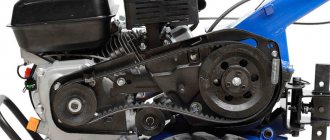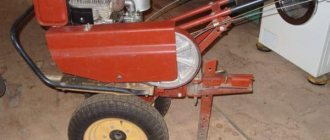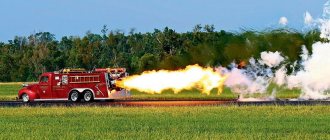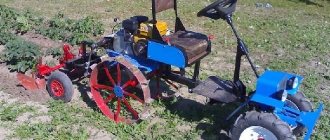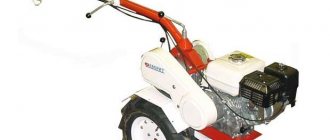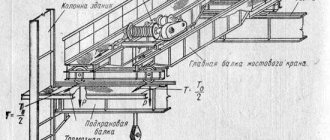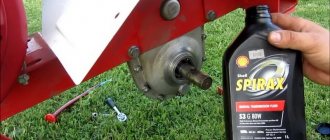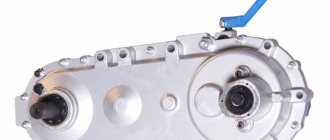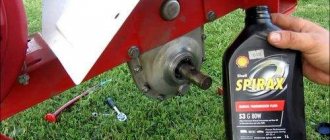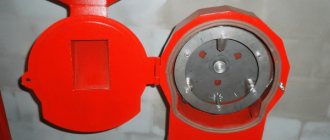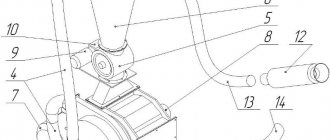The main products produced by JSC KO-Neva are
walk-behind tractorsAndmotor cultivators. These products are manufactured under the brand name “Mototekhnika NEVA”. The products are designed to perform a wide range of agrotechnical and economic operations (ploughing, cultivation, weeding, hilling, planting potatoes, digging up root crops, watering, cleaning the territory, transporting goods). One of the key mechanisms of motor vehicles that ensures their reliability and operational efficiency is the gearbox. You can buy a gearbox for the NEVA walk-behind tractor, as well as a walk-behind tractor, cultivator and attachments in our stores sales representatives, as well as intrade and exhibition complex in St. Petersburg. The price of the product may vary depending on the region of sale. You can install the transmission on the equipment yourself, or by contacting service center.
- Worm gear
- Chain reducer
- Gear reducer
- Gear-chain reducer
What is a gearbox for a walk-behind tractor?
The standard gearbox of a walk-behind tractor is a power unit that transmits torque from the engine and transmission directly to the working shaft on which cutters or wheels are mounted.
It bears a significant power (work) load. Modern walk-behind tractors use different technical solutions for this unit:
- gear transmissions;
- chain;
- worm;
- combined.
The gear housing (housing) is sealed. There is a gasket between the body and the cover. The seal is necessary to retain the oil. All rotating parts of the unit operate in an oil bath.
Located at the bottom of the walk-behind tractor in the center. On cheap models it may be non-separable and cannot be repaired.
Homemade design
You can make a gearbox for a walk-behind tractor with your own hands. Before starting work, it is necessary to take into account the engine speed and calculate the maximum load on the mechanism shafts.
Without determining these parameters, the assembled gearbox will not meet the specified power and will quickly fail . Here's what the build process looks like.
- We make the body. To do this, you can borrow a finished product from a motorcycle. If you don’t have a motorcycle at hand, you can weld the body yourself from sheet metal.
- Gears can be removed from the Friendship 4 chainsaw or you can also make them yourself. When making gears yourself, you need to take into account the diameter of the gearbox housing. Therefore, the size of the gears is determined using a caliper.
- To operate the mechanism you will need two gear shafts. These elements can be removed ready-made from the Ural motorcycle and installed in the walk-behind tractor gearbox after minor modifications. At the first shaft, you need to shorten the end cap and drill a hole in the housing. The second shaft is installed on the opposite side of the housing, where you first need to cut a hole of a suitable diameter. The hole must be supplemented with a flange, which is attached to the body using threaded connections. We install a steel washer and a ball bearing inside the flange.
- We connect the shafts to each other using a transmission mechanism.
- We supplement the output end of the shaft with a pulley, which will serve to install a belt drive.
After these manipulations, you will get an angle-type gearbox.
Classification of gearboxes used on walk-behind tractors and their characteristics
Below are the main types of such units that can be found on modern walk-behind tractors.
Angular
This type gets its name because it turns and transmits torque at an angle. Most often at a straight line, 90 degrees. This may be necessary when installing attachments - a rotary snow blower, a header, an active cutter, etc.
Angular gearboxes can be zero, which do not change the speed. And also increasing or decreasing. Overdrives increase the number of revolutions of the output shaft in comparison with the input, which results in a loss of power. Downshifts, on the contrary, reduce the output speed and increase force.
The picture shows an angular gearbox for mounting a snow blower:
The output speed is determined by the needs of the attachment. Where high speeds of the working body are required, booster units are installed. Where low speeds and power are needed, on the contrary, lowering ones are installed.
Downward
The operating principle of all reduction gearboxes is simple: a small gear rotates a larger one in diameter. A larger gear has a larger radial arm. The greater the leverage, the greater the force.
Most gearboxes have several gears that alternately transmit torque to each other. A reduction gear can be any type: worm, gear, chain or combined.
Some engines for walk-behind tractors are equipped from the factory with a reduction gearbox with a gear ratio of approximately 2:1. That is, at the output from the engine shaft, for example, 3600 rpm. At the output from the reduction gear shaft - 1800 rpm. But the rotation force is 2 times greater.
This is the engine in the picture. In the foreground is the cover and shaft of the reduction gearbox for a motor cultivator:
This is a complex mechanism equipped with an automatic (centrifugal) clutch.
But it cannot be considered as some kind of separate special device. This is an integral part of such a motor.
Motoblocks also use other reduction gears, most often homemade.
Gear
These are gearboxes in which rotation is transmitted using gears. Due to the dense and deep engagement of the gear teeth with each other, large power loads are transmitted. Knots of this type are used on the most powerful machines and mechanisms.
Gears are made of special durable steel that is resistant to breakage and abrasion. They rotate in oil, which extends their service life.
The image shows a repair kit, a set of gears for such a gearbox:
Disadvantage of this type: manufacturing high-quality gears with minimal tolerances is a high-tech, expensive process. High-quality gearboxes are expensive. If, in order to reduce the cost, the parts are made of poor quality, the unit does not last long.
Worm
A spiral helical worm gear rotates the gear. At the same time, the speed decreases many times and the force on the output shaft of the gear increases.
The advantages of this solution are simplicity, a minimum of parts, and a rigid grip.
The downside is that with constant rotation, the rubbing surfaces of the spiral and gear teeth wear out quite quickly. Especially if they are made of low-quality alloys and with large tolerances (low accuracy).
The photo shows an example of such a gearbox:
Gearboxes of this type are very suitable for opening gates, covers of industrial equipment, etc., that is, where the mechanism makes a minimum of revolutions. And the revs themselves are low. With constant loads and rotation of the working shaft of the walk-behind tractor, wear can be accelerated.
Equipment
Converters are either collapsible or non-dismountable. Basically, the latter type can often be found in the configuration of budget walk-behind tractors. They feature inexpensive spare parts that cannot be replaced. In the event of a breakdown, there is only one way out - replace the entire gearbox. The service life of such models declared by the manufacturers is 1-2 seasons, provided they are used correctly.
More expensive equipment can boast of a dismountable gearbox that can be repaired: failed parts can be replaced with new ones. Therefore, the service life is several times longer compared to inexpensive devices.
The converter package consists of:
- Cases - collapsible or not.
- The rotor shaft is responsible for torque.
- Gears of different sizes.
- Chain or belt - depends on the type of gearbox. In the case of a chain transmission, movement occurs due to sprockets - star-type disks. If the transmission is belt driven, then the equipment has pulleys on which the belt is put.
- Bearings - reduce friction between rotating elements and ensure their free rotation.
Through these components, movements are transmitted from the motor to the attached parts. Belt converters are weaker and unreliable. If the torque is high, then the belts begin to fly off the pulleys. But such a structure has a positive effect on the engine shaft. This situation can be avoided by replacing them with gear ones. But then you will have to change the pulleys too.
All parts are located inside the case. In addition to the installed set of components, you can also add elements for lubrication of bearings inside the device. These include an oil pump or a cooling device.
Design and principle of operation
The design and operating principle of the main types of gearboxes are described above. In addition to them, chain gearboxes are used on walk-behind tractors; this design is used on Cascade brand cultivators. They operate with gears, the rotation between which is transmitted using chains. They have reverse.
There are also combined mechanisms. The picture below is gear-chain type:
Types of mechanisms
According to the method of operation and action, all transforming mechanisms for walk-behind tractors are divided into several types:
- angular;
- downward;
- reverse with reverse speed (reverse gearbox);
To redirect rotational energy from a vertical drive to a horizontal plane, an angular gearbox using bevel gears (bevel gearbox) is used.
Reducing the number of revolutions and increasing the power of the drive mechanism is provided by reduction gearboxes, or creepers for the walk-behind tractor. They are considered the most reliable for operating a diesel or gasoline air-cooled walk-behind tractor. This allows them to be used for particularly difficult work - for example, plowing heavy soil or harvesting potatoes using a potato digger.
Criteria for selecting a walk-behind tractor by gearbox type
If the walk-behind tractor is low, it means it is equipped with a gear reducer. This type is compact, so the entire walk-behind tractor and its center of gravity are located noticeably lower than other options.
A low unit is easier to work with. There are no chains that tend to stretch over time, which leads to malfunction. The downside of this option is that it is noisier. And there are problems if the parts of the assembly are made of poor quality, from cheap alloys. In terms of complexity, such a unit is comparable to gearboxes of a car and other machines and units.
The most common type of gearbox on walk-behind tractors is the gear-chain gearbox, shown in the image above. It combines the advantages of a gear and chain gearbox, but has the same general disadvantages - chain stretching. The gearbox is tall, so units with it have a high center of gravity.
Varieties
The gearboxes with which walk-behind tractors are equipped seem identical only at first glance. In fact, these devices can be divided into three groups. The differences lie in the design features of the gearboxes. Let's get to know the representatives of this family in more detail.
Angular
Angle-type gearboxes are elementary structures that serve to connect the transmission to the power plant of the unit.
The structure of this node looks like this:
- Mechanism body.
- Belt drive pulley with fastening.
- Rotor shaft.
- Flange complete with mounting and bearing.
- Washer and fixing key.
Gear
This is a more complex mechanism, which is impossible to recreate at home without special skills and knowledge.
Gear reducers are called reduction gearboxes. Thanks to its design features, the mechanism reduces the engine speed, simultaneously increasing the power output of the walk-behind tractor.
Such gearboxes have a long service life, so they are suitable for performing various jobs, and do not suffer mechanical damage even under peak loads.
Reversible
This mechanism is based on a clutch that moves freely between bevel gears.
Such gearboxes enable the walk-behind tractor to move in reverse, which has a positive effect on the maneuverability of the equipment.
However, this comes at the cost of reduced performance and maximum speed. Therefore, each farmer decides independently whether to install a reversible gearbox or not.
Gearboxes installed on walk-behind tractors from different manufacturers have virtually no design differences. Therefore, disassembling the unit and replacing failed parts will not cause difficulties.
Making your own gearbox step by step
It is impossible to make a full-fledged gearbox with a crankcase, axles (shafts) on bearings and sets of gears or chain sprockets on your own. This is a complex assembly that requires a production line with many high-precision machines to produce. Sometimes owners adapt ready-made reduction or angular gearboxes from other machines and mechanisms for their units.
The simplest version of a reduction gear (more precisely, a reduction gear) is shown in the following video:
Chains and chain sprockets from a motorcycle were used here. It is impossible to describe step by step all the actions of such tuning. Main stages:
- In front of the factory gearbox, a homemade stand is placed under the working shaft, on bearings.
- Large gears from a motorcycle, a pair, are attached to the working shaft. One on each side of the rack.
- Small sprockets are mounted on the shaft located in the factory gearbox.
- Chains are stretched between the sprockets, like on a motorcycle.
The design must include a device for adjusting chain tension.
Kinds
Depending on the type of transmission used in the gearbox, converters are divided into several types. Different devices are used in mechanisms of different fields of activity.
Chain
The name is due to the design of the gearbox, which is based on a chain as a transmitting element. There may be more than one in one device. The movement is provided by sprockets, the small one is the leading one, the big one is the driven one. The principle is similar to the system on a bicycle. Productivity and reliability depend significantly on the quality of materials used to manufacture the main driving parts.
Among the negative aspects, the need for regular maintenance should be highlighted: chain tightening, lubrication. Unlike a belt drive, a chain drive does not allow slipping and lasts longer.
With reverse
The reversing mechanism provides the equipment with the ability to reverse. In this case, the reverse rotation clutch is installed between the bevel gears, which are located on the main shaft.
Belt
The simplest gearbox available on the market is of the belt type. As a rule, budget gearbox models use just such a device. The belt serves as a transmission element that is attached to the pulleys. Under heavy loads, the belt slips or breaks.
Belt converters reduce the aggressive effect on the power plant, reducing jerking. In addition, their design is simple and repairs are easy.
Among the minuses, unfortunately, there are more factors.
- At high temperatures the belt stretches. This is what reduces grip.
- Rapid wear and tear.
- Belt drive rupture due to kinks or twists.
- As the speed increases, the belt begins to slip.
- The pulleys must be in the same plane.
Gear
Gear reducers are most often used in engines of heavy equipment. The transmission consists of a gearbox, differentials and regulator, gears and belts. The design of the device is simple.
A gear transmission contains bevel or spur gears. Due to the fact that several of them can be placed on one shaft at once, the dimensions of the converter are reduced.
Among the advantages, one can also highlight the quietness of the engine on this type of gearbox.
Worm
The worm gear inverter features long service life and high reliability. The design is considered not very complex and requires qualified maintenance. The worm gear is already angular. In addition, it has a reverse, which allows the equipment to move not only forward, but also backward.
The gearbox got its name from the presence of a special worm gear in its composition, which moves along a screw having a trapezoidal four- or two-start thread. By varying the number of teeth, you can change the rotational speed. All components are made of anti-friction steel, which is characterized by increased strength.
The converter consists of only two main components. In addition, it is quiet and smooth.
Angular
One of the most efficient and reliable gearboxes. Therefore, it is used to equip production machines and equipment operating under heavy loads. This type of converter is also actively used in the automotive industry.
The angular gearbox ensures the connection of the engine with the transmission, which is designed for chain drive
Please note that the magnitude of the load will depend on the quality of lubricants and temperature conditions
Downward
The goal of a reduction gearbox is to reduce the number of revolutions while increasing power. This is achieved by using a gear system. As a rule, modern converters of this type are equipped with an air cooling system.
Model range of gearboxes for walk-behind tractors
All gearboxes of the above types are on sale. When choosing a new gearbox, you should first of all take into account compatibility - the unit must simply match the specific model in terms of dimensions, mountings, and gear ratio. At the same time, the specificity of modern walk-behind tractors is that the same model can have both different engines and gearboxes.
For example, let’s compare the well-known and popular Russian walk-behind tractor Neva MB2 with the traditional and new Multiagro gearbox.
Traditional gearbox:
- unlocking on one wheel . When rotating, one wheel is easy to turn in only one direction;
- gear shifting on the gearbox cover , which is inconvenient when traveling with a trolley. You have to stop, get off the cart and approach the walk-behind tractor to change gears;
- 2 forward speeds, 1 reverse speed . If you transfer the transmission belt to pulleys with a different gear ratio, the number of speeds doubles. As a result, 4 speeds forward, 2 reverse.
New Multiagro gearbox:
- two wheel unlocking . The left and right locking handles are located on the steering wheel. With their help it is easy to turn in both directions, and not in one;
- gear shifting using a cable is moved from the gearbox housing to the steering wheel, which is convenient;
- more gears: 3 forward, 2 reverse . When throwing the belt 6 forward 2 back.
It is still difficult to compare the reliability and service life of these different models. The new unit has been on sale relatively recently, approximately since 2022. But it was developed and tested for quite a long time. In terms of functionality and convenience, Multiagro has a clear superiority. This is a Russian production, St. Petersburg, .
Cross-section of the Multiagro gearbox:
A gearbox with gear switching on a walk-behind tractor essentially gives only advantages; it is a kind of analogue of a car’s gearbox. This is the responsible node. If performed well, it can have a fairly long service life. The main thing that depends on the owner to extend the service life of such units is the smooth activation of speeds, control over the quantity and quality of oil.
Selection rules
You can make a converter for a walk-behind tractor with your own hands, but if you do not have skills in this matter, then it is better to buy one. There are high-quality modifications on the market, the price of which varies depending on various parameters.
The price factor may be affected by:
- Quality of materials for components.
- The number of options that the reducer performs.
- Manufacturer.
- Presence or absence of reverse.
- Power. When choosing, you should give preference not to high power, but to the characteristics of the machine, because The capabilities of the gearbox and motor must match.
- Design.
- Term of the work. If you choose the right equipment, it will last 7-15 years, which depends on the type of transmission.
For a small car, a centrifugal clutch is often used in the transmission. Its essence is to prevent movement from starting when the engine starts and warms up. This is convenient because in winter regions it is impossible to move or start work without preparation.
When purchasing a converter, you must also remember about the engine parameters. Before choosing a gearbox, you need to think about the oil that will be poured into it. It matters because it guarantees efficient and uninterrupted operation.
In addition to the above, the choice of converter may be influenced by:
- climate. If the vehicle will be used in northern regions, then it is better to choose those products that do not freeze when the temperature drops. In the southern regions this is impractical;
- load. In the case of heavy soil or virgin soil, the load on the walk-behind tractor will be increased. In other words, friction between parts will increase, which will lead to increased torque. In such conditions, you can increase the service life of parts if you select a lubricant that takes this into account;
- oil seals. If they are of poor quality, oil leakage cannot be avoided. As a result, its residues will boil when overheated, which will lead to jamming of the components.
In addition, you need to buy products from a manufacturer that has branches in your region. This is important because In case of wear, parts must be replaced with similar ones.
